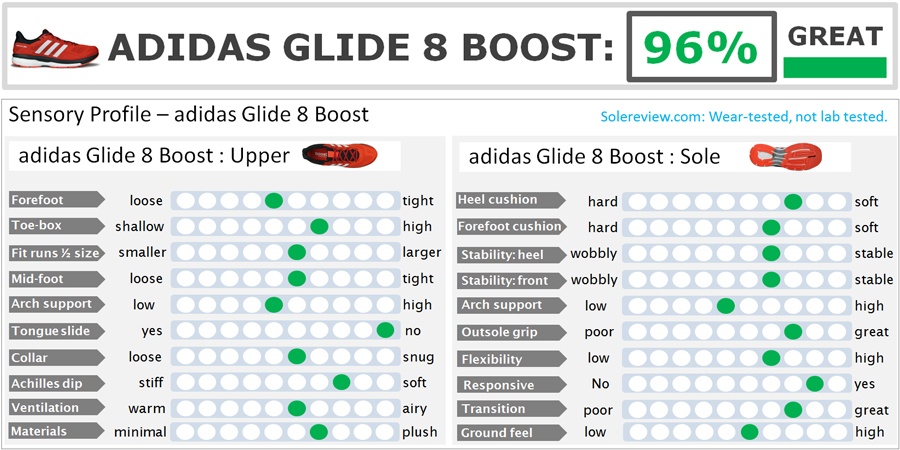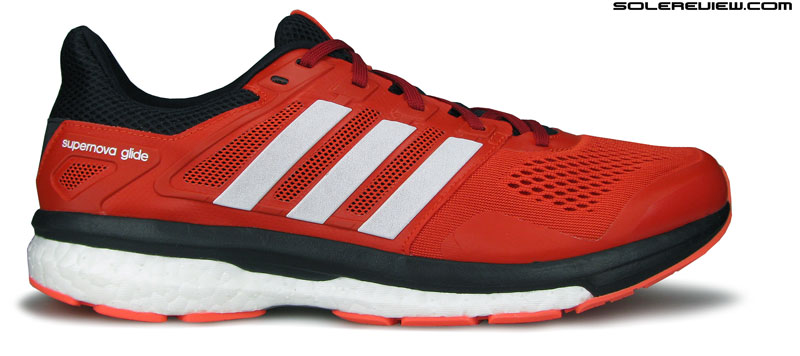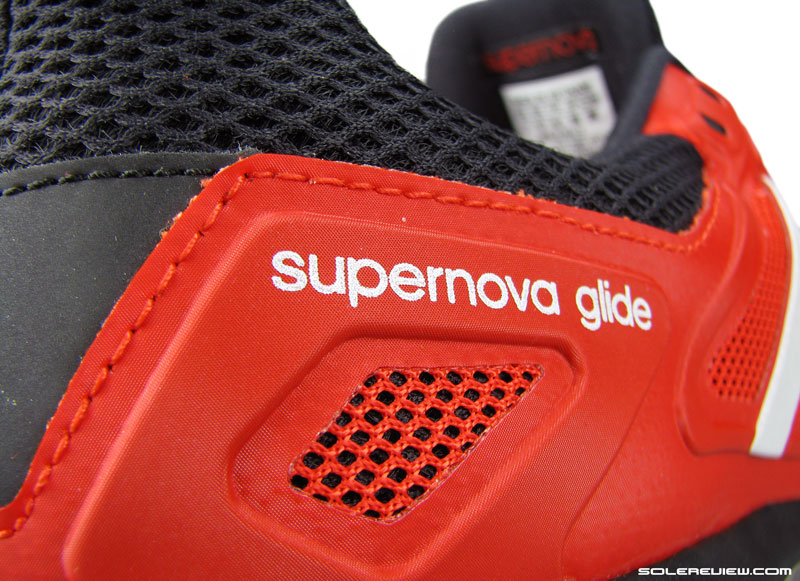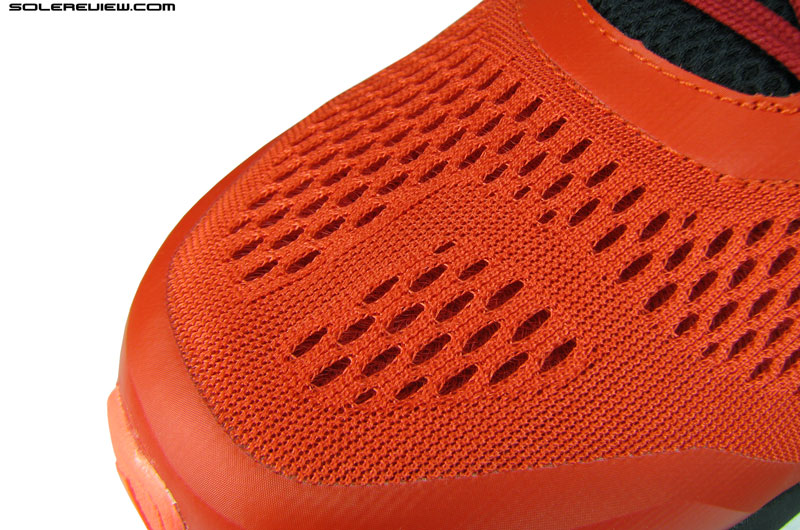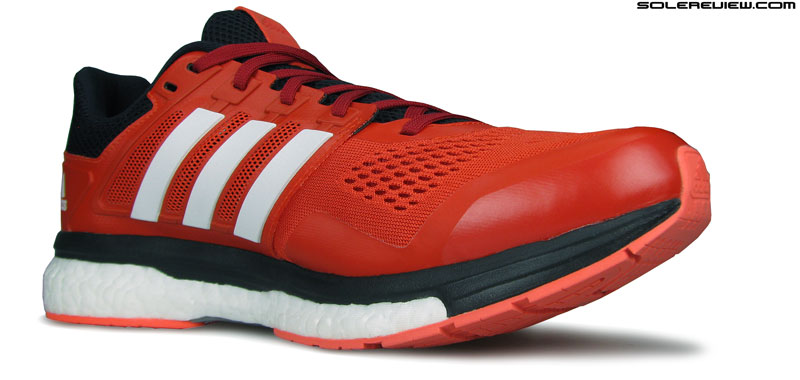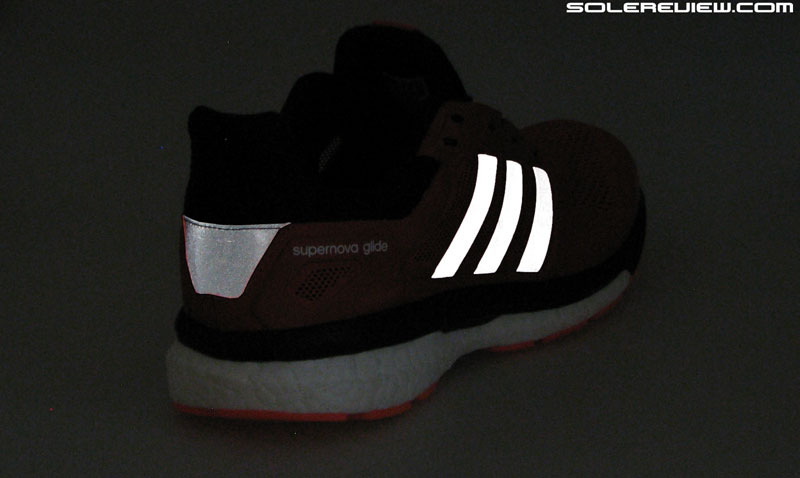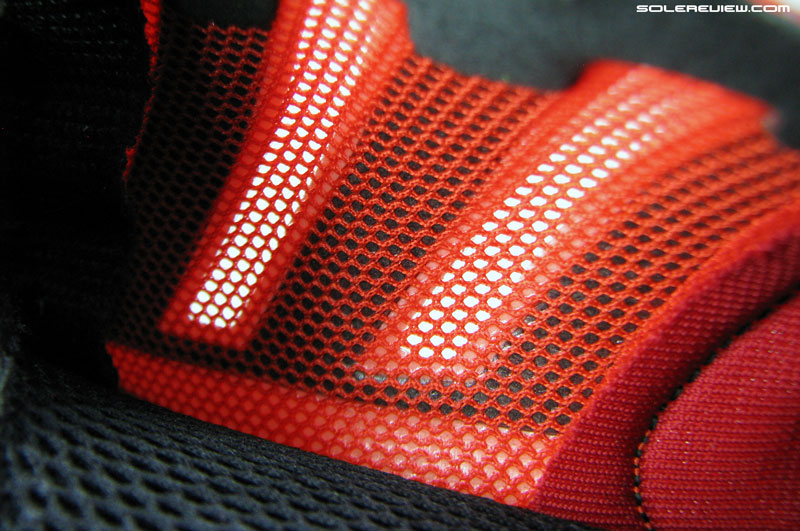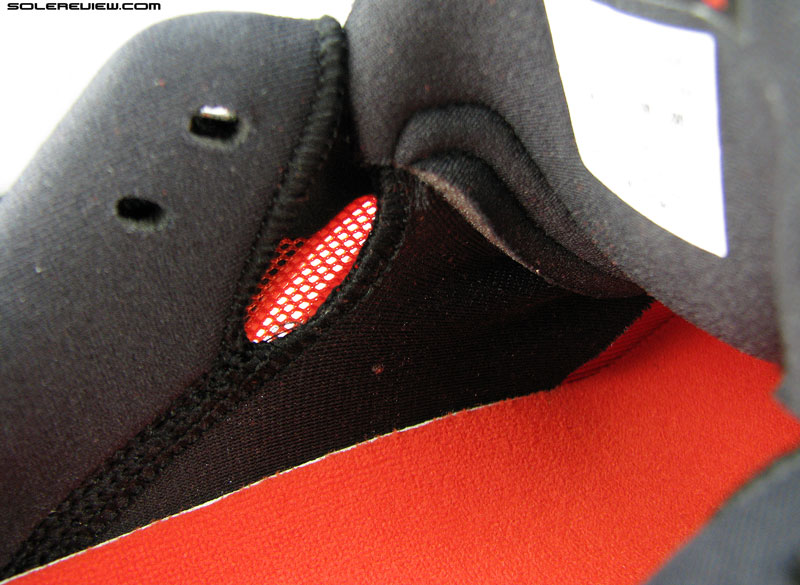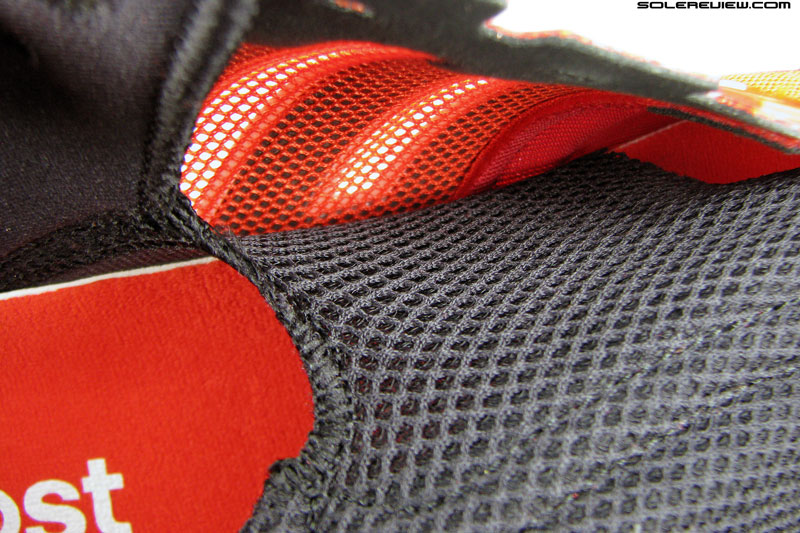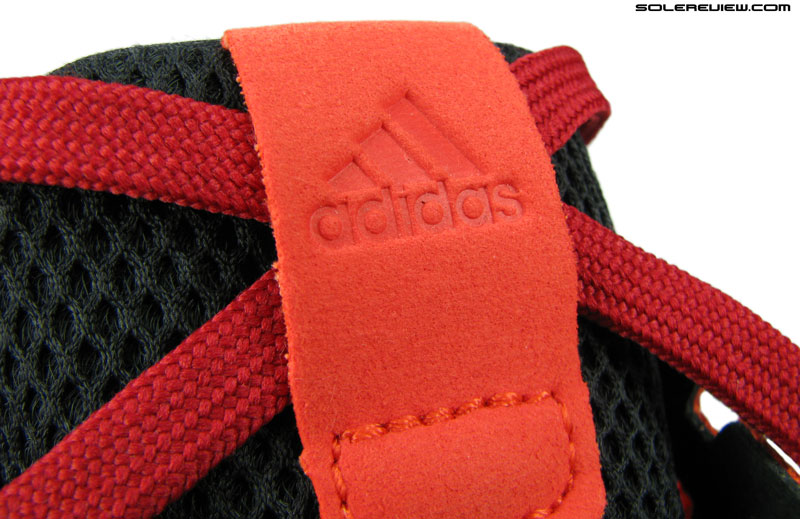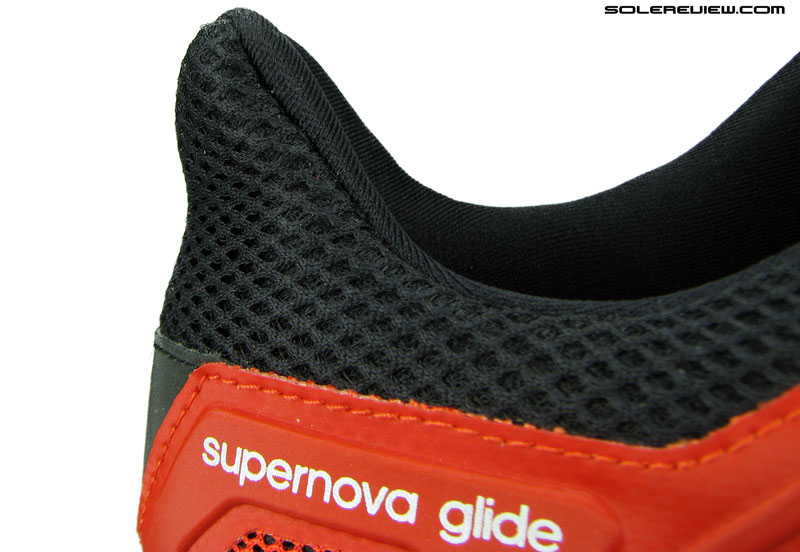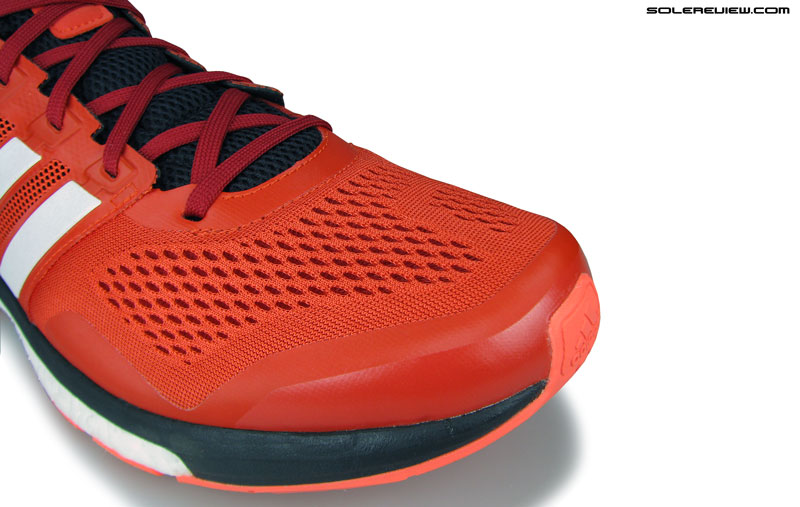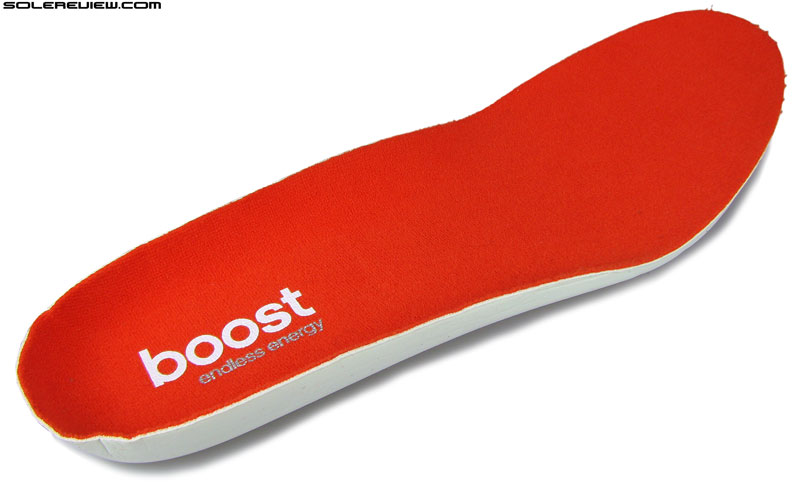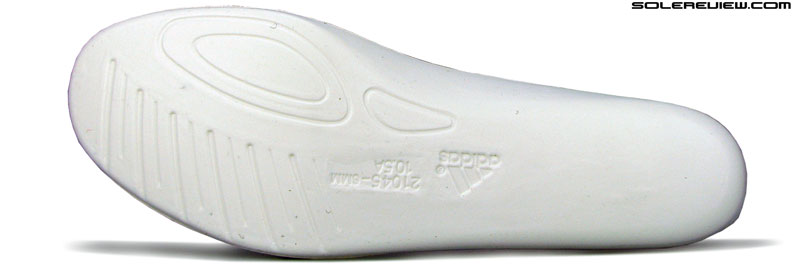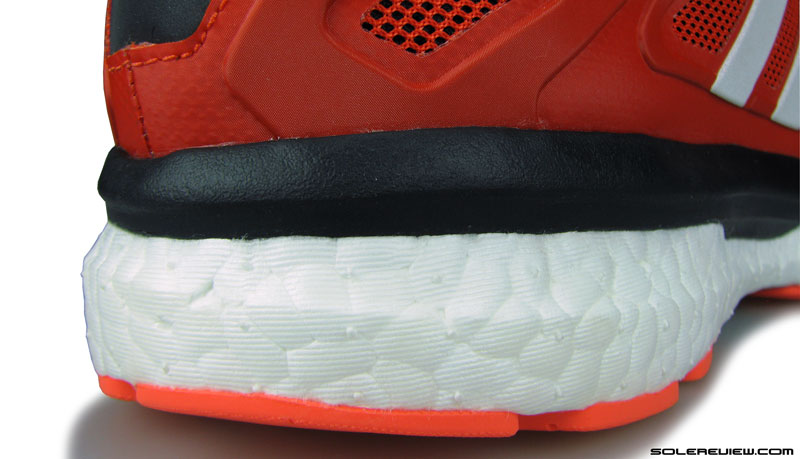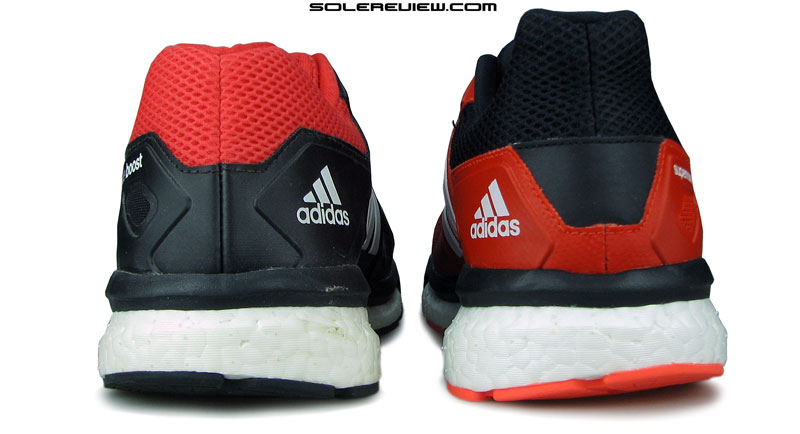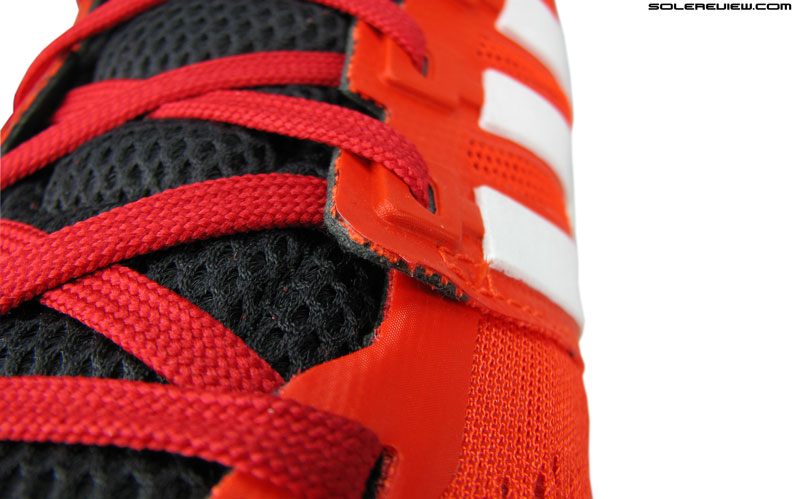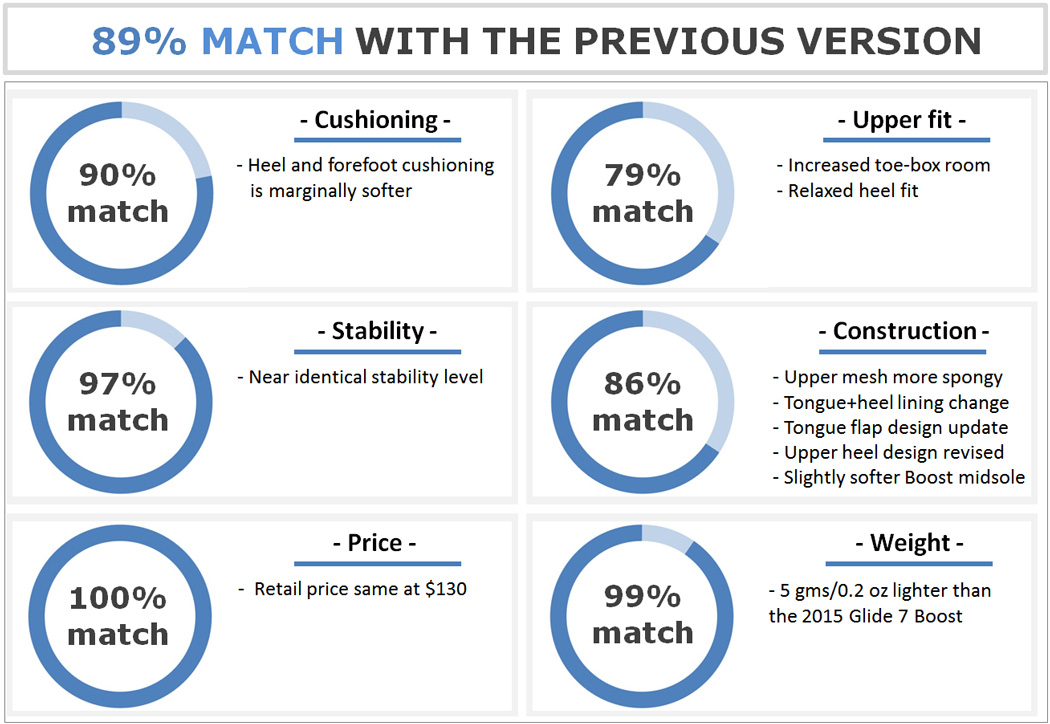There’s a sense of déjà vu about this one. And it makes sense though, because this happens to be the second review for the Glide 8 Boost. Okay, the first review wasn’t a full ‘solereview’, but we covered a lot of talking points when we voted the adidas Glide 8 Boost to be the best running shoe of 2016.
But hey, where’s the fun if we don’t do our 3,000+ words, dozens of pictures and scorecard thingy?
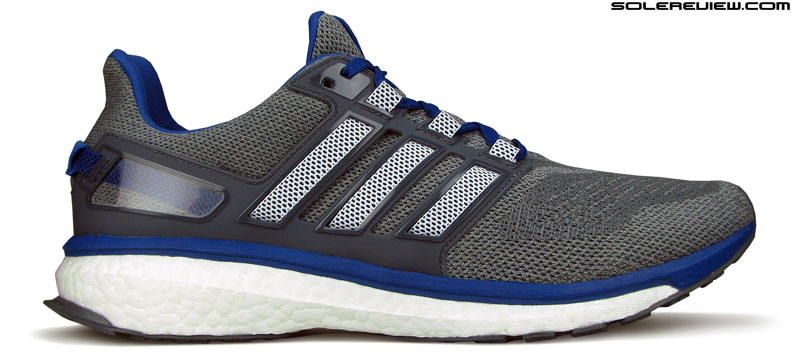
The Energy Boost (version 3 pictured here) was the first adidas shoe to feature a midsole material which would eventually change the brand’s fortunes.
The Energy Boost was the first adidas running shoe to feature the now proven Boost midsole material. That was followed by a quick conversion of many long continuing models to the Boost platform; amongst them was the adidas Supernova Glide 5.
The pre-Boost Glide 5 was the one of adidas’s full feature models – luxurious upper materials, and a chunky EVA foam midsole with the shape shifting ‘Formotion’ heel insert.
With the ‘Boosted’ Glide 6, the model changed overnight to a more minimal version of what it once used to be. The upper design turned much leaner, and the relatively busy midsole toned down to the dual-density design we know today. So while adidas chose to retain the same name, there was a world of difference between the pre and post Supernova Glide models.
Not only did the upper fit become spacious when compared to the non-Boost Glides, there was a level-up in the ride’s firmness and rebound quality. And that’s what everyone loves about the Boost midsole; it is cushioned without feeling soggy, and there’s a sense of consistency absent in most regular EVA models.
A large volume Boost foam midsole all by itself isn’t that stable, but throw in a few stabilizing components and the result is a ride quality which mixes ample cushioning with stability.
Out of the Boost model we’ve reviewed, the Energy, Glide, Adios and the Boston have a firm EVA rim which helps achieve a stable ride. That said, what makes the Glide unique is that the amount of Boost foam below the rim is just right. It does not go overboard on the softness aspect, neither does the shoe feel overtly firm.
And ever since adidas achieved this magical balance on the 2014 Glide Boost 6, they have done little to upset it. This is a good thing – because far too often, many running shoe models change into something completely different than the one which made it loved in the first place.
Luckily for us, the Glide Boost 8 happens to be a study in incremental evolution, making only small changes to what previously worked so well. In doing so, they have kept the ride character and the overall visual scheme virtually unchanged.
A minor flip side to this is that all the Glide Boosts look so similar to one another. For someone new to the adidas product line, it is entirely possible to mix up one Glide Boost version with another.
The least adidas could have done is to suffix the Glide Boost name with a number; they do it on their website, so why not on the shoe? And all the other brands do so to prevent confusion. The Asics Nimbus has Nimbus 18 clearly written on it, Brooks calls out what version (number) on the Ghost and the Glycerin, and so on.
The visual sameness does have a very bright side. Since the design has remained more or less unchanged, the shoe retains the same ride and fit character which made the Glide Boost 7 excellent. But surely, something must have changed on the Glide 8 Boost?
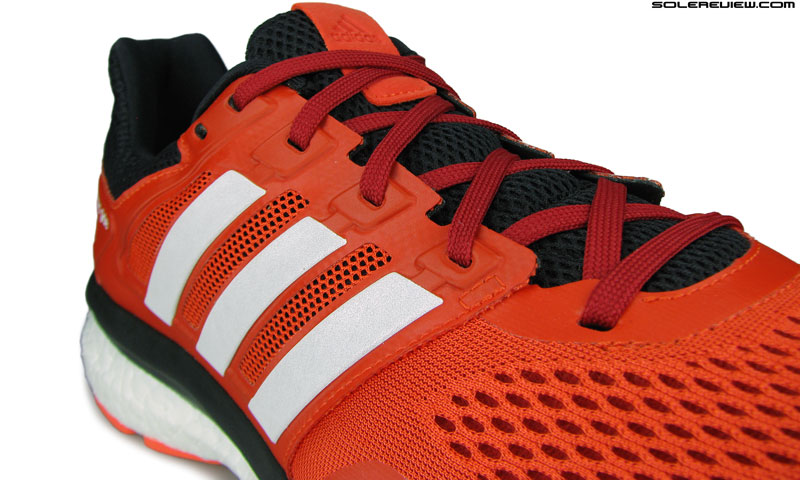
A lot of the upper is same-same. The Glide 8 Boost blends in synthetic leather panels with engineered mesh, which was true for the GB6 and 7.
The GB8 version picks up where the 7 left off, applying minor updates to a now familiar upper landscape. Like the GB7, the 2016 Glide Boost depends on the same set of materials to base its upper on.
The upper forefoot is a combination of engineered mesh and fused synthetic; except that there are a couple of differences.
If you squeeze the engineered mesh, you’ll discover that it is more springy than the one which the Glide 7 came kitted with. The engineered mesh has two fabric layers – the first one being on the top with a combination of vented and dense knit structures, and the second layer being the inner lining. While the Glide 7 mesh felt a bit flat, the new mesh used on the 8 has a springy feel to it.
The upper layer and inner lining is connected by a network of yarns, and that gives the mesh more volume than the variety used on the GB7 – and hence a more sponge-like behavior. This is a welcome evolution of the engineered mesh, something which Nike has also started incorporating into its ‘Flymesh’ design.
While the earlier versions used across brands felt flat, brands are now combining the comfort benefits of traditional spacer/air mesh with the structural quality of engineered mesh – a design which integrates ventilation and support in a single piece of fabric.
The midfoot panels of the GB8 are near identical to the 7. The synthetic leather covering has molded details leading up to the lacing, and also doubles up as the adidas logo.
The 3 stripes are reflective, and when paired with the heel insert, the Glide 8 Boost turns out to be more night-running worthy than the Glide Boost 6 and 7.
Though both the current and past Glide versions look almost identical around the midfoot area, there are a few differences.
The adidas side stripes are separated by a net mesh; while this was true for the GB7 as well, the mesh used this year is much more open in construction.
Standard Glide Boost fitments such as the inner sleeve have been carried forward from the Glide Boost 7.
Mind you, it isn’t a full sleeve, but only happens to be a very wide gusset – meaning that it does not extend all the way into the forefoot. The tongue is quilted in the way of the GB6 and 7, and has a few changes.
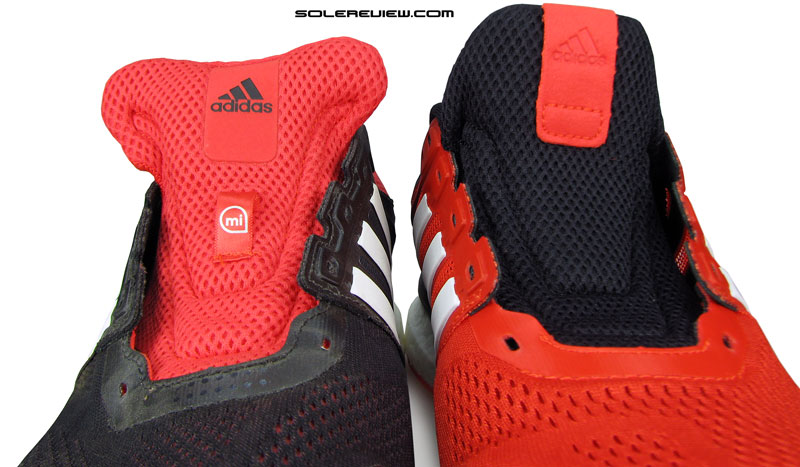
The GB8 (right) has a traditional tongue this year. The GB6 and 7 (left) tongue had these funny looking flaps.
The tongue flap loses its dog eared design, and switches to a regular flap. The small adidas logo on top is now a loop instead of the fused synthetic; the tongue does not slide, but now you can pass the laces under the loop if you wish.
And glad to report that adidas has lost the mi-coach logo on the center loop; on both the Glide 6 and 7 versions, it confused people no end. The mi-coach logo was relevant when you had to insert the pod device inside the left shoe. Now with built-in smartphone accelerometers, the make of the shoe does not matter anymore. MiCoach would work perfectly even with a $16 Walmart shoe.
The tongue lining has changed to a textile with a smoother hand feel. The new lining material used on the GB8 is similar to what’s on the Ultra Boost models, and the same fabric is used on the collar too. And in the back, the lining isn’t the only common trait which the new Glide shares with the more expensive Ultras.
On both the Ultra Boost models – the standard and the ST – the upper Achilles area has a pronounced ‘lip’ instead of a traditional design. It’s kind of a pull tab integrated into the upper heel, and it also changes how the heel fits.
Both the Ultra Boosts had no precedent, but since the Glide 8 has history with the heel design, a difference in fit is noticed vs. the Glide 7.
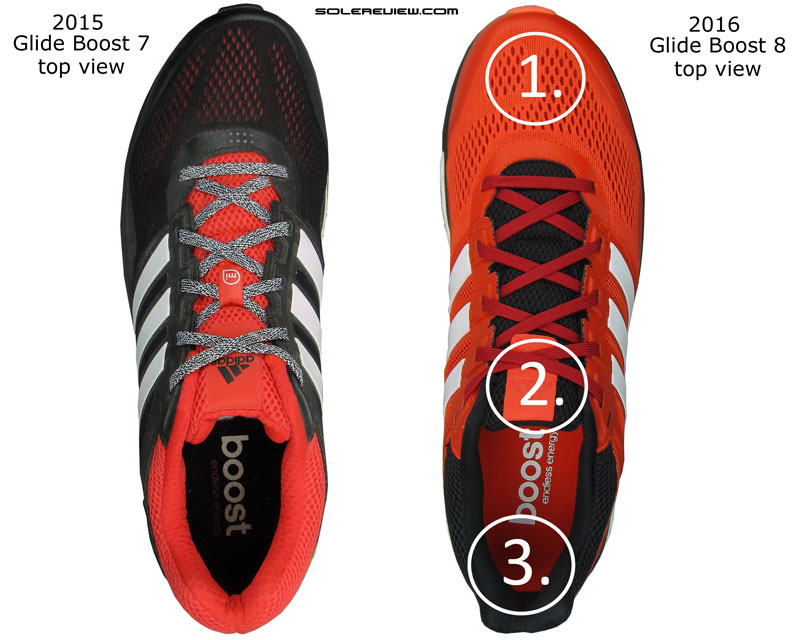
1) Marginally increased forefoot room 2) Revised tongue design 3) The heel opens up a bit due to the lip design.
That is because of how the Achilles area curves inside (or the lack thereof) on the GB8 vs the GB7. The Glide 7 has a traditional heel set-up, which is basically a hard internal heel counter padded over with mesh and foam.
Since the GB7’s heel counter was of a standard height, the top closed in narrow over the foot and delivering a sensation of heel grip which was confidence inspiring.
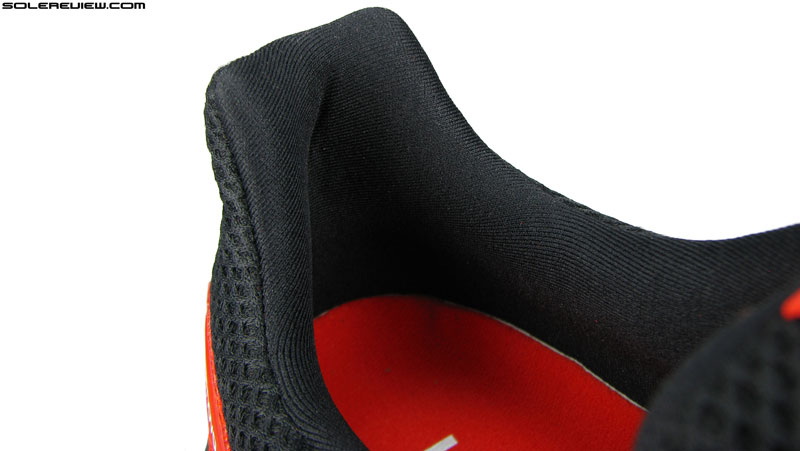
The only downside of the lip design is that the heel does not feel as secure as it did on the GB7. But for all practical purposes, this is a non-issue.
The Glide 8’s heel curves over briefly, then the tall flap tapers away. So while the heel doesn’t actually slip, it feels a bit loose.
That said, the Ultra Boost-esque design certainly feels gentler on the Achilles than the Glide 7 did.
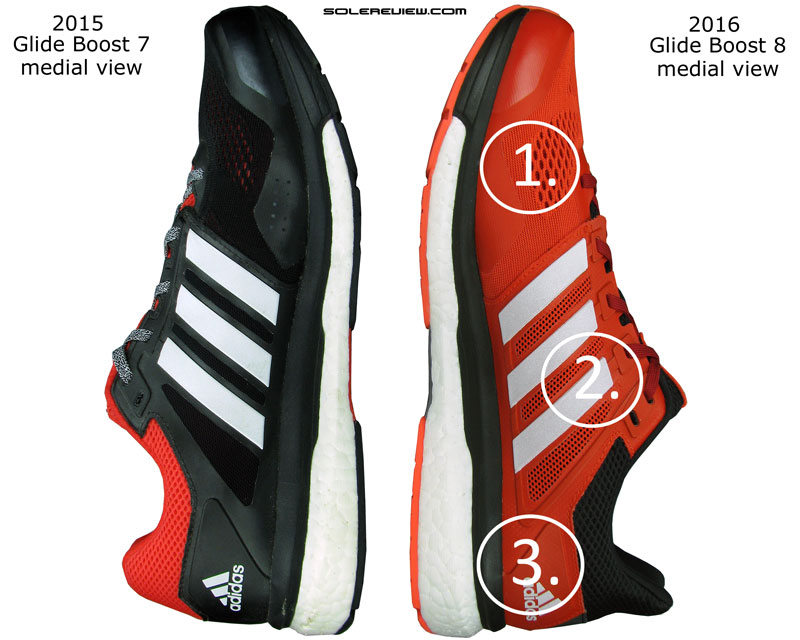
1) Slightly more medial toe-box room 2) No change in midfoot fit 3) Heel grip does not feel as confidence inspiring as the GB7
As far as the midfoot fit is concerned, it feels exactly the same as the Glide 7. The lacing rows are placed with generous spacing between them, so the top-down pressure of the Glide Boost is a little more than what you’ll experience on an Asics, Brooks or Nike equivalent.
The laces are flat, which cinch well without coming undone halfway through a run – some round laces have that tendency. Thankfully, the Glide Boost’s laces poses no such problem.
The forefoot and the toe-box is slightly more spacious, and that’s not because of the upper design. Sure, there are minor changes such as the molded toe-bumper taking a slightly different shape and the updated placement of fused layers, but that’s not it.
Like how the Vomero 11’s narrow heel caused the forefoot to feel narrower, the Glide 8 Boost demonstrates the opposite. By a more accommodating heel fit, there is a slight relaxation of the forefoot fit.
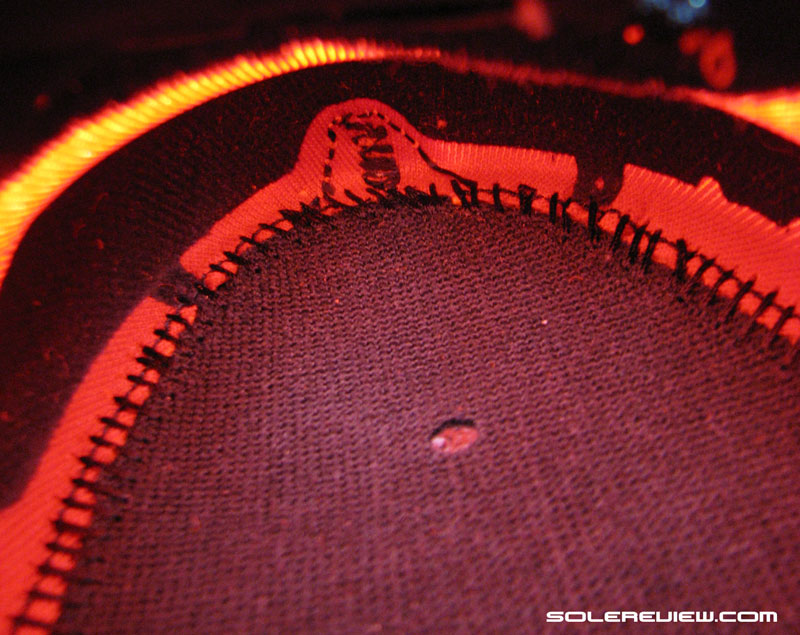
The Glide Boost has been one of the few adidas shoes to have a spacious toe-box right from the beginning.
Besides this fit change, there’s little else to report. The Glide Boost has been one of those rare adidas running shoes with a relatively spacious forefoot/toe-box, and that holds true for the 8th version too.
This basically means that if you’re a US 11 in other brands such as Asics or Brooks, then there’s a pretty good chance that you’ll fit in the same size for the Glide 8 Boost too.
One of the things which adidas needs to urgently fix is the availability of optional widths, or rather the lack of. Currently, adidas does not offer widths in most of their running shoes. Much smaller brands offer widths, so it is very strange that a giant company like adidas stays away from delivering what is now commonplace.
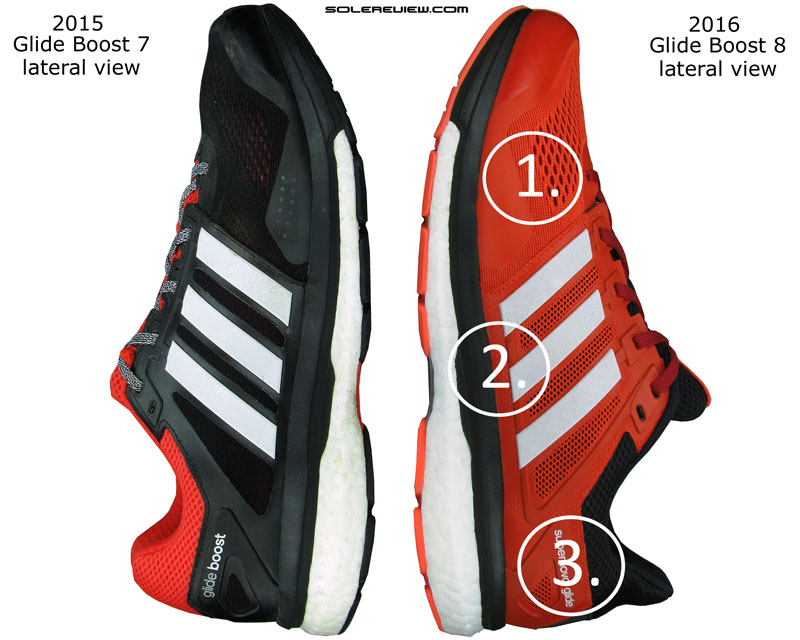
1) The forefoot mesh has a more sponge-like feel 2) Black EVA midsole layer hasn’t changed 3) Heel feels softer than the GB7
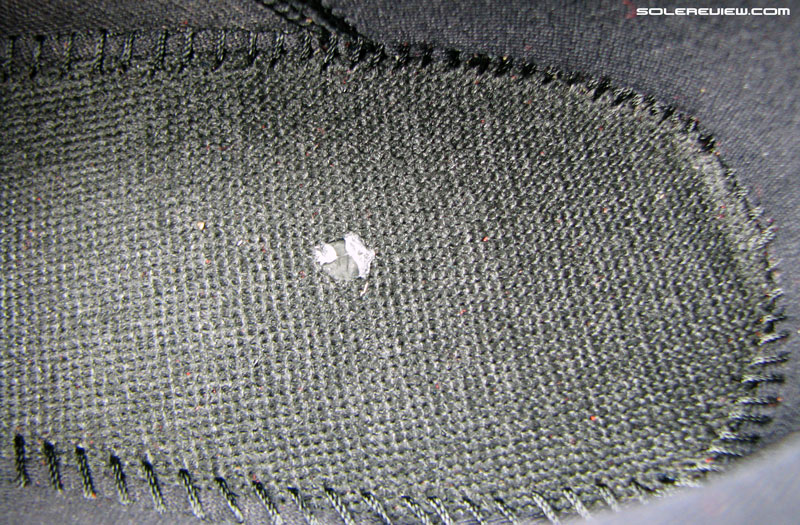
The black EVA layer isn’t just a rim on the Glide Boost 8. It goes over the soft Boost foam, imparting a firm feel to the ride. Which is a good thing, by the way.
The lower part of the Glide 8 Boost is identical to that of the GB 6 and 7. The design and part sharing happens to be an exact copy of prior versions, down to the lasting fabric used below the removable insole.
The midsole is part EVA part Boost in approximately a 25:75 ratio. Unlike the Energy Boost, the firmer EVA isn’t a rim, but a separate sheet above the Boost foam till the midfoot.
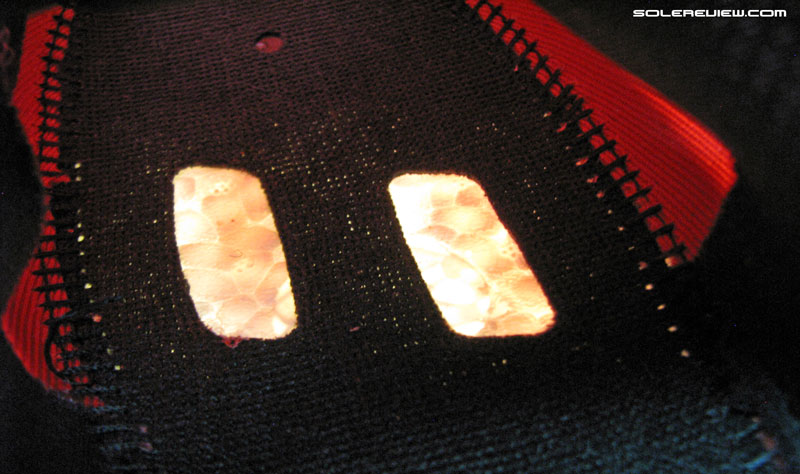
The Boost foam is exposed under the forefoot, providing easier access. This also makes the cushioning feel consistent in relation to the heel cushioning.
Over the forefoot, the lasting has two ‘windows’ to expose the Boost foam and make it more accessible during runs.
The exposed windows also means that the EVA foam does not go over the forefoot like it does over the mid and rearfoot. The black EVA forms a supportive rim on either sides of the forefoot midsole.
The insole is the same as that inside the Glide Boost 6 and 7. It is molded EVA foam of a generous thickness, and works well together with the Boost midsole. The outsole is constructed using the now proven Continental rubber.
One of the reasons (among many others) why we named the Glide 8 Boost the best running shoe of the year is its near-indestructible outsole.
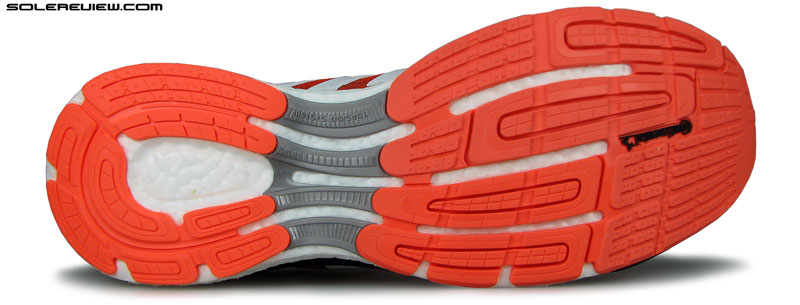
The legendary durability of the Glide Boost outsole. No change from the GB7, and that’s a very, very good thing.
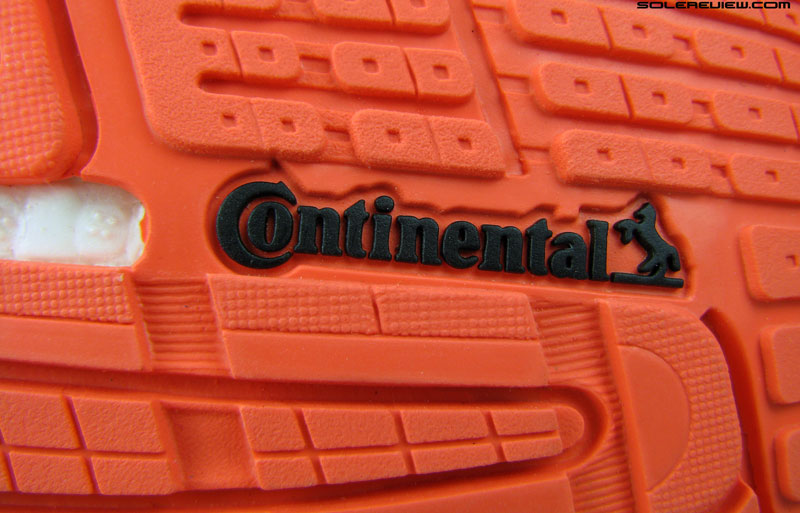
While the Continental rubber used on the Glide is very durable, it isn’t so for models such as the Ultra Boost, where a softer compound has been used.
Many readers have reported that the GB outsole easily lasts more than 600-700 miles, and a few have taken it past the 1,000 mile mark. When paired with the crease defying Boost foam, you can be run assured knowing that the Glide 8 Boost is the most durable running shoe available today.
Shoes such as the Pegasus 31 and 32 also have long lasting outsoles, but the regular EVA foam midsole above it will have a shorter lifespan than its ‘Boosted’ counterparts.
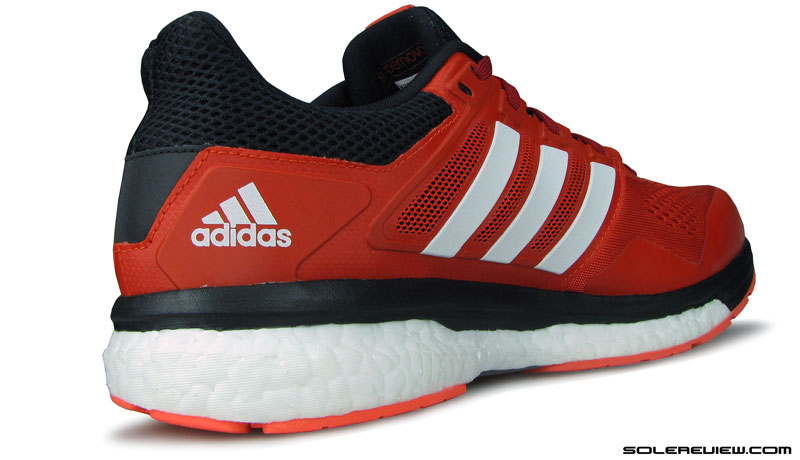
The combination of firmer EVA (in black) over the resilient Boost foam makes the Glide Boost’s ride a perfectly balanced one.
One of the things which the Glide 8 Boost does very well is to balance the amount of Boost and EVA foam. Other Boost shoes such as the Ultra Boost ST are without question very cushioned, but for some it might be a little too much of a good thing. The firmer EVA+softer Boost combo approach on the Glide makes the ride cushioned but not overtly soft.
The dual density midsole also makes the Glide’s ride responsive, as the firmer EVA layer helps better leverage the Boost foam’s rebound properties. The ride also feels extremely consistent, with no soft sink spots anywhere.
We talked about the Glide Boost’s versatile nature in our best running shoe feature; the cushioning accented with a bit of firmness makes this shoe a handy tool for many occasions. The Glide 8 Boost works great for the long and slow, and it’s also a good stand-in for faster days too. Ok, not of the caliber of the adios Boost, but works just fine.
Unlike Boost overloaded adidas models, the firmer EVA midsole part keeps the ride supportive as well. So it isn’t a surprise that we called out the Glide Boost as a ‘supportive neutral’ in our recommended list of stability shoes.
The two pieces of the flat outsole is also joined by a plastic Torsion plate, and that lends some stiffness under the shoe as well.
It’s always hard to explain how soft or firm a shoe rides unless you have a few reference points. It is firmer than an Asics Cumulus 17, but softer than a Brooks Ghost 8. The heel cushioning softness is on par with the Nike Pegasus, though the Glide’s cushioning quality is of a different type.
The Boost foam makes the GB8 much more responsive than any of the shoes mentioned. There is a certain element of rebound or spring-back which we’ve yet to encounter in other brands. The Nike Zoom Air is a worthy equal, but the air bags only make a specific part of the midsole responsive, and not the entire area.
And is there any difference in the between the Glide Boost 7 and 8, ride-wise?
We found the Glide 8 Boost to run slightly softer than the GB7. There was no change in how the EVA rim or insole was constructed; nor was the outsole rubber softer.
As it turns out, the Boost foam on our pair of the Glide 8 was easier to compress when compared to the GB7. Now, this could be a manufacturing anomaly, but we thought to mention it. Just how softer, if one had to put it in numbers? Around 15% softer than the Glide 7.
These small variances aside, the tried and tested sole design of the Glide Boost – which has been unchanged since version 6 – is a big reason why the shoe is so good. The upper stands out by making the forefoot more spacious in relation to many other adidas shoes, and its midfoot does not have the uncomfortable plastic cage of the higher priced Energy Boost.
So if adidas changes the sole design on the Supernova Glide Boost 9, we’re very curious how adidas deals with the process. Because tweaking a shoe which is as well rounded as the Glide 8 Boost requires kid-glove treatment, and then some.
(Disclaimer: For this review, Solereview bought the shoe at full US retail price.)
Looking to upgrade your 2015 Glide Boost 7 to the latest version, but not sure how the latest 2016 model compares? We can help here. The following info-graphic is a ready-reckoner for what changes you might expect in the new model vs. old. To make this more fun, we’ve put in a system of percentage match, which calculates a weighted average for a set of attributes.
A higher or lower match percentage is neither good or bad. The % number just tells you how similar or distanced the new shoe is from the previous version. Total match % is a result of weighted averages.

